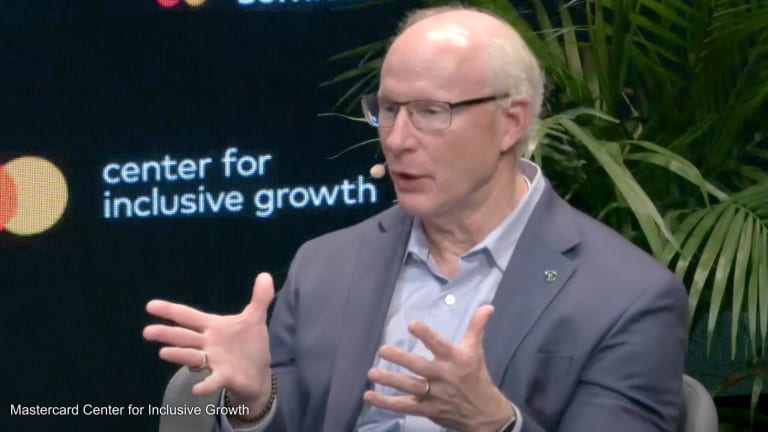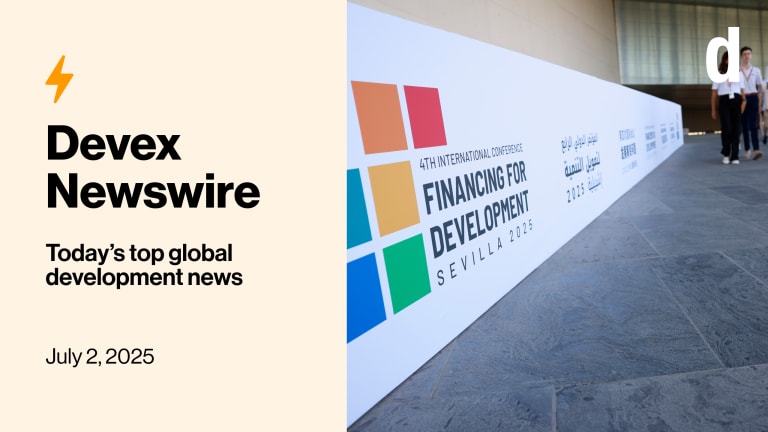
As the challenges facing development, philanthropic, and humanitarian organizations grow more complex, they can’t afford to stay behind the scenes if they want their approaches and solutions adopted. To win government support, increase funding, and attract diverse partners, they need to wield influence — and that influence comes from visibility driven by telling human-centered stories.
That’s according to Rimjhim Dey, founder and CEO of DEY. Ideas + Influence, a firm that specializes in amplifying big ideas for NGOs, foundations, think tanks, and other organizations tackling the problems that vex humanity. She sat down with Devex to explain why the sector must break free from risk-averse, calendar-driven communications and be more proactive.
This conversation has been edited for length and clarity.
Why do development and humanitarian organizations need to rethink how visible they are?
There has been a sea change in the pressures facing large and small development organizations. In the old days, they were silent partners working behind the scenes. They didn’t want to be very visible, particularly with sensitive governments and donors, and often relied on “letting the work speak for itself.”
But there’s a growing recognition that the challenges facing humanity — whether that’s climate change or mpox — are global and often interconnected. Organizations can no longer implement and scale their solutions without building deeper consensus, bringing in more partners, and getting the support of more governments.
The problem is, you can’t influence change or build partnerships if key stakeholders aren’t aware of who you are and more importantly, what you stand for. And visibility is the foundation of influence.
What opportunities are organizations missing in their communications, and how can they rectify this?
A successful communications strategy visibly forwards your organization’s interests. It sounds simple, of course, but you’d be surprised at how often an organization's long-term objectives get divorced from its communications function.
What we instead see is that too often organizations let their calendar drive their communications — they only tell stories when they need to announce new funding, projects, or partnerships, or to mark diary events like the World Economic Forum or the United Nations General Assembly. There is a place for this, certainly, but it should only be a small part of your strategy because these things are typically uninteresting to journalists and broader audiences. They want to get deeper into what’s really happening on the ground. What are the particular challenges you’re facing right now? What are the solutions? How do these issues interrelate with broader global concerns? And how to put a human face to it all.
So you have to take a step back and identify the big idea or set of ideas you’re trying to convey and how they are pertinent to what’s going on in the world geopolitically and culturally. This sounds elementary, but it’s missing 95% of the time. If the world isn’t primed to hear what you have to say right now, you’re talking into the ether.
Finally, it’s also critically important to tell stories through actual human beings — whether that’s a grantee, the head of an institution, or a small-scale farmer. Journalists and stakeholders crave real voices that break out of the standard PR playbook. People, particularly your leaders, can bring the data, research, and initiatives to life, and make your stories relatable. But you need to get them out there. And, this means taking some risk.
Why is human-centered storytelling a game changer for communications, and how open are development organizations to this?
If you think about which people in the development world stand out, they’re the ones who are willing to speak their minds — whether it’s Mia Mottley, the prime minister of Barbados, the World Bank’s Ajay Banga, or The Rockefeller Foundation’s Dr. Rajiv Shah. By talking candidly about the challenges they face, they not only get more visibility but they’re seen as visionary leaders who have the desire and firepower to get things done.
Unfortunately, there’s so much risk aversion at the top of organizations that they sometimes avoid broaching big ideas or thinking concretely about audiences and end up speaking only to each other about safe, stale topics. This approach may not annoy donors but it also doesn’t move the needle on urgent issues that need real attention.
But if an organization like Gavi, the Vaccine Alliance, for example, can improve the uptake and accessibility of vital vaccines by speaking openly about which governments are not paying, that benefit far outweighs the downside of upsetting a donor. I’m not saying that risk aversion is always inappropriate, but development organizations, in particular, really have to examine how being risk-averse can hurt their mission.
Tsitsi Masiyiwa calls for trust and humility in philanthropy
To have a greater impact, philanthropic funders ought to let local funders decide how money gets spent, according to the Zimbabwean billionaire and philanthropist.
Some of this caution stems from organizations’ in-house communications teams, and that’s understandable. If they let senior leaders make a risky maneuver and a donor gets upset, or if they say something unwelcome to leadership, it’s their job on the line. It’s easier for consultants like us to come in and speak truth to power. If you don’t like us, our business will not collapse. I care more about our credibility and giving you real feedback that helps you in the long run.
Could you offer an example of an impactful communications strategy within the development sphere that you’ve worked on? What made it so successful?
Several years ago, we worked with a client who started a new center within a large global think tank that focused on the problems of climate change. She was savvy enough to understand quickly that these are very broad topics, and that it would be more effective to develop and own a specific focus area for her external platform that was urgent and resonated with what was happening in the world. This was before 2023’s hottest summer on record, but we could see already that heat was becoming a topic of concern in broad circles. The impact of extreme heat was not only relevant to her organization’s mission, but it was also urgent and timely, and not many people were speaking about it consistently.
Beyond identifying a salient platform, this leader was also willing to put herself out there in a compelling, sometimes provocative way, through interviews, events, and op-eds to discuss how governments were failing to address the impacts of extreme heat — and that drew attention. We focused on quality over quantity, for instance prioritizing op-eds for high-impact outlets like The Atlantic or Foreign Affairs, knowing that one placement in these publications was far more valuable than 10 op-eds in outlets like Forbes.
We were also thought partners in pulling highly creative levers to get more visibility during those “lulls” between announcements and calendar moments. We helped them identify allies who could act as ambassadors to drum up noise on the issue; suggested they commission research reports — for example, zooming in on how extreme heat affects women; and urged them to be creative in their calls to action, such as when they urged the World Meteorological Organization to start naming heat waves like they do for hurricanes.
So at the end of the day, we had a visionary leader who was passionate, creative, collaborative, and willing to take calculated risks — and the campaign was hugely successful. Our client deserves a lot of credit for raising awareness about an issue that has since become very high profile.
Do you have any final practical tips that organizations can implement today to move their storytelling in the right direction?
First, build relationships with the journalists and influencers you want to communicate with. Take time to figure out what they write, what makes their heart beat, and give them what they need. For example, rather than pepper spraying the press with releases, could you invite one or two along for the ride as you visit a refugee camp to witness firsthand how you’re issuing digital IDs for humanitarian aid based on blockchain? Because when we connect human to human, that’s when great storytelling happens.
Second, put a human behind every story, especially your organization’s leadership. Leaders often worry that raising their profile might seem self-serving. But it’s important to recognize that their visibility is actually not about them — it's about amplifying and humanizing the issues core to their organization to drive meaningful change. It’s also important to let your leader be seen for who they truly are — whether a musician, an avid cook, or something unique. One client, for example, personalized his annual letter by leading with his background as a former journalist and South African, making him more relatable and intriguing.
Finally, break out of the echo chamber. You have to understand how your organization’s ideas and solutions relate to global trends, issues, and current events so you can better frame your message in ways that resonate beyond your core stakeholders. Whether you’re in communications or the leader of an organization, you have to expose yourself to different opinions, speak with people from different generations, cultures, or religions, check out media that might not align with your worldview, and take in some new art, music, or literature.
Learn more about DEY. Ideas + Influence and human-centered PR here.








